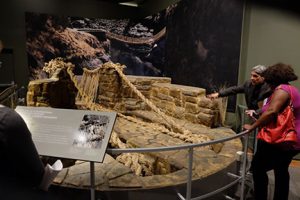By Professor Tiffany Banks On Tuesday, September 30th , students from my COMM 108: Foundations…

After Spring Break, the Fellows were eager for our meeting at NMAI (National Museum of the American Indian). We began the afternoon with Dr. Jose Barreiro, Assistant Director for Research and curator of NMAI’s exhibit, The Great Inka Road: Engineering an Empire.
The first part of his presentation was devoted to an overview of the factors that led to the museum’s creation, as well as a growing discussion about how to best respect and preserve artifacts that often include items sacred to particular tribes. An ongoing part of museum’s mission has been to correct long-standing misperceptions about Native Americans that many have.
As we moved toward the exhibit itself, Dr. Barreiro began with a brief description of the museum’s physical space. He noted that NMAI has no corners and is oriented to the 4 cardinal directions and is centered on 4 basic themes: Living Earth, Community (what defines one as an Indian), Encounter, and Expression (the Indian tradition is a thinking tradition). The museum also showcases the flags of 567 federally recognized nations.
Our tour of the exhibit, The Great Inka Road: Engineering an Empire provided us with the history of the region and he evolution of the Inka culture. Innovations that were highlighted included the Inka’s use of tension forces in bridge construction, and the engineering methods devised to manage and control water, vital to their survival.
On returning to the Conference room, we found one more highlight was waiting for us, a viewing of a documentary titled “Chawaytiri on the Road: Return to Pisac”
The documentary centers on a group of 25 Quechua families who took a caravan of llamas from their home village (Chawaytiri) on a 4-day, ~60 km journey to the city of Pisac. Their goal was to demonstrate that their ancient traditions are very much alive. Their message is simple, ‘Let us be careful not to lose the ways and customs of our ancestors, so that nothing useful disappears.’ This was the first time in 20 years that these families made this journey. In the past, they were not well received by the people in Pisac and so they stopped walking with their llamas into the city. Fortunately, this journey was a much more positive experience and they were welcomed by the people of Pisac. These villagers suffered greatly under the Spanish hacienda system. In the 1970s, this system was eliminated and the native populations are now reclaiming their land and culture. These Quechua families greatly value artifacts from their ancestors and the idea of ayni (reciprocity). They believe in peace, harmony and the importance of community life.
This video can be viewed on YouTube.
Needless to say, everyone was sorry when this afternoon came to an end.





This Post Has 0 Comments